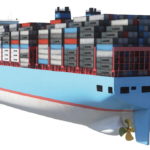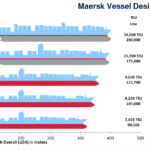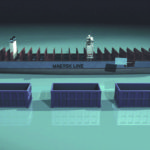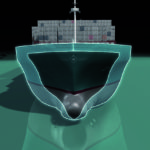Danish Maersk Line signed a contract with Korea’s Daewoo Shipbuilding & Marine Engineering Co., Ltd.(DSME), on February 21, 2011, to build ten new mega-containerships of 18,000 TEU capacity each. Furthermore they added options for additional 20 vessels of the same type. Deliveries are scheduled for the years 2013 until 2015. These ships will entirely change the shipping industry’s understanding of size and efficiency. They will be the largest and most efficient ships with 400 m length, 59 m beam, 14.50–16.50 m draught and consequently 165,000–200,000 tdw.
These new giant container vessels were projected under the name »Triple-E«, based on the three main purposes of their[ds_preview] creation:
• Economy of scale
• Energy efficiency
• Environmentally improved
The synonym »E-3« was used already in the early 1990s by European cooperating yards EUROYARDS for the innovative design of a double-hull-tanker after several disastrous tanker accidents. At this time the three »E«s stood for: European, Economic and Ecological. Today, only the first E changes in its meaning from »European« to »economy of scale«. So, this current giant contract has its roots in Europe only, the rest is gone and to be done in Far-East. The Maersk-Group ran own yards in Denmark, Lithuania and Germany but decided to close all their shipbuilding activities after February 2012.
The new mega-containerships do not just set a new benchmark as to size. They will surpass the current industry records for fuel efficiency and CO2 emissions per containers moved, held by the »Emma Maersk« class vessels (see HANSA 9/2008, page 96–104) built at Danish Odense Staalskibsvaerft. Dimensions of Maersk Line’s »Triple-E« class container carriers offer only a few meters in extra length and width over the »Emma Maersk« class of ships giving 16 % more container capacity, coming from 15,500 TEU to now 18,000 TEU.
There have always been discussions about the largest size of container carriers, mainly counting the number of containers they can stow on and under deck and disregarding whether these containers are loaded or empty. When international agreements tried to settle these differing views by fixing the theoretical average container (TEU) weight at around 14 t, Maersk always calculated traditional figures by dividing the deadweight by the average container weight, e.g. less than 12,000 TEU for »Emma Maersk« in the beginning instead of realistic 15,500 TEU today.
The »Triple-E«-class will produce 20 % less CO2 per container moved, compared to »Emma Maersk« and 50 % less than the industry averages on the Asia–Europe trade-lane. In addition, it will consume approximately 35 % less fuel per container than the 13,100-TEU vessels being delivered to other container shipping lines in the coming years, also for the Asia-Europe trade.
The new »Triple-E«-class vessels are designed exclusively for the trade between the Far East and Europe. The Suez-Canal gives no limitations to these designs. On the other hand these ships cannot pass the old/new sluices of the Panama-Canal (L = 294/366 m; B = 32.25/49 m; D = 12/15 m; 4,500 / 12,000 TEU).
The extreme width of 59 m (23 rows of containers on deck) of this new class of containerships might open discussions for even wider container loading cranes at various existing ports. The state-of-the-art of container loading cranes is designed for the »Emma Maersk« class of container vessels (B = 56.40 m; 22 rows across deck; more than 60 m outreach over the quay-edge to the water). The maximum draught of 16.50 m might be the same problem for both new Maersk Line classes.
Optimized container stowage
Just a few meters wider across the beam from 56.40 m to 59 m give one more row of containers over the full length, from now 22 rows across to then 23. »Triple-E« class ships are nearly equally long but wider than »Emma Maersk« class, and as they need to have a lower draught they are more bulky. But here again, the average container weight is coming into the picture. For the »Triple-E«-class the design-draught is named at 14.50 m (~165,000 tdw), although the scantling draught allows 16.5 m (~200,000 tdw). So, they are capable of carrying more containers in the holds, and the average container weight can be between 9.17 t and 11.11 t per TEU.
Separating the traditional unit navigation bridge / superstructure from the engine room on existing container vessels (one third of the length to the stern just over the huge single two-stroke diesel engine) – into two units (engine room with funnel as far aft as possible, navigating bridge and accommodation block one third of the length to the bow) has freed the majority of the mid-ship and makes possible a better utilisation of the main deck over the bulky hull-form. This accounts for an added capacity of 550 TEU.
The navigation bridge now in a more forward position allows higher container stacks above deck without restricting the necessary visibility forward which gives an added capacity of approximately 250 TEU. Behind the superstructure, too, containers can be stacked higher. Moving the main engines further aft and shorting the main engine room furhtermore allow stowing more container stacks in the holds, thus giving an added capacity of approximately 750 TEU altogether.
Efficient propulsion
To increase the efficiency of the propulsion plant of »Emma Maersk« and to reduce fuel consumption as well as exhaust emissions the maximum possible speed of 27 kn was lowered to 25 kn. But the »Triple-E« speed will be capped further, to 23 kn. This means a power requirement of only 65–70 MW becomes realistic, compared to »Emma Maersk’s« 80 MW in the main diesel engine alone. This is more than 10 % reduction in the diesel engine power.
But this lower maximum speed of the vessel alone enables Maersk Line to consider engines with much slower revolutions – the »Ultra-Long-Stroke« diesel engines from MAN B&W. They provide the greatest fuel efficiency because they allow the most efficient and powerful large propeller diameters. However, the size of the propeller is limited by the dimensions of the vessel and the space available beneath the keel. To investigate these restrictions and achieve the desired efficiency, Maersk Line Research determined that a two-engine / twin-propeller / twin-skeg system might be better than a single-engine / one-propeller setup. In addition it becomes possible to shorten the propulsion department. »Emma Maersk’s« main engine (Wärtsilä 14RT-Flex96C) is nearly 26 m long and weighs 2,300 t, whereas the »Triple-E«’s two main engines side by side (MAN B&W 7 G80ME-C9) need only 12.50 m length and weigh 2 x 960 t.
»Triple-E’s« two propellers are 9.80 m in diameter with only four blades each, compared with »Emma Maersk’s« single propeller, which is 9.60 m in diameter with six blades but much heavier loaded. The combined diameter of the propellers provides greater pushing power in the water and fewer numbers of blades creates less resistance. The »Triple-E« propulsion system thus consumes approximately 4 % less energy than »Emma Maersk« with her huge single two-stroke diesel engine and her high-duty single fixed-pitch six-bladed propeller.
Waste heat recovery (WHR)
Both, energy creating and propulsion units, use advanced waste heat recovery (WHR) systems which provides a greater energy recovery than electrical power for additional ship propulsion as well as shipboard services. On board »Emma Maersk«, the plant is employed to gain benefits in terms of better fuel economy, reduced exhaust emissions or increased propulsion power.
In this concept, exhaust gas energy across the load range is increased by using a different turbocharger matching when engine air is drawn from the ambient air instead of from the engine room. Usually marine engines are designed for intake temperatures of up to 45 °C in tropical conditions with turbochargers drawing intake air from the engine room. If instead the intake air is drawn from outside the engine room thorough an air intake duct, the maximum intake temperature can be assumed to be no higher than 35 °C.
The lower air intake temperature allows the turbochargers to be re-matched to return the thermal load of the engine back down to what prevails for the intake temperature at 45 °C. The thermal load of the adapted engine will then be no greater than that of the usual engine so as not to jeopardise engine reliability.
The re-matched turbochargers allow more exhaust gas to be branched off compared with conventional tuning. Therefore the re-matched system gives both an increased exhaust gas temperature for an exhaust gas economiser and an increased branched-off exhaust flow for an exhaust gas power turbine.
Exhaust energy can thus be recovered and applied in both a steam turbine and exhaust-gas power turbine to generate electrical power, equivalent to 11 % of the engine power. The electrical power can be employed either in a shaft motor / generator or in supplying shipboard services. The generated power can thus contribute significant savings in both fuel costs and exhaust emissions (CO2, NOx, SOx, etc.). The payback time would depend upon the installation design and its operating costs, but would be expected to be less than five years.
On board »Emma Maersk« the WHR plant also offers an attractive possibility for powering the larger container ships, which need often more propulsion power than is available from the in this case 14-cylinder Wärtsilä RT-Flex96C engine. The standard engine gives an MCR power of 80,080 kW, thereby having a continuous service output (85 % load) of 68,068 kW. At this engine rating, the total WHR plant would contribute a shaft power of 7,390 kW (~11 %). The combined service power for propulsion would therefore be 75,458 kW, equivalent to an engine MCR power of 88,770 kW for a plant without heat recovery.
Although not all technical details are really known of the »Triple-E«-class, it can be assumed that the WHR-system is similarly arranged.
MAN B&W »Ultra-Long-Stroke« diesel engines
Late in October 2010, just after the SMM 2010 exhibition in Hamburg, MAN Diesel & Turbo surprised the maritime world by the announcement of an »Ultra-Long-Stroke« diesel engine and explained: »The first G-type engine, designated G80ME-C, has a design that follows the principles of the large-bore Mk-9 engines series that MAN B&W introduced in 2006. The G-type is developed with a longer stroke to reduce engine speed, thereby paving the way for ship constructions with unprecedented high-efficiency«.
Ole Grøne, well-known Senior Vice-President Low-Speed Sales and Promotions, MAN Diesel & Turbo (former MAN B&W Diesel, Copenhagen) said in a statement: »MAN Diesel & Turbo always follows developments in the shipping market closely and we have kept a close eye on the trend for fuel optimisation in recent years. As such, we have experienced great interest in the G-Type engine during extensive consultation with industry partners and currently we are working on a variety of projects with shipyards and major shipping companies. As a result, we have reached the conclusion that the introduction of the G-type engine programme is both viable and timely«.
Grøne added proudly: »The G-type is an ultra-long-stroke engine and represents the biggest development within the engine portfolio since the successful introduction of the ME electronic engine within the last decade«. Tankers and bulk carriers have traditionally used MAN B&W S-type engines with their long stroke and low engine speed as prime-movers, while larger container vessels have tended to use the shorter-stroke K-type with its higher engine speed.
Larger container vessels in recent years have also been specified with S80ME-C9 and S90ME-C8 engines, because of the opportunity they offer, to employ larger propeller diameters. Following efficiency optimisation trends in the market, MAN Diesel & Turbo has also thoroughly evaluated the possibilities of using even larger propellers and thereby engines with even lower speeds for propulsion of tankers and bulk carriers.
Such vessels may be compatible with propellers with larger diameters than current designs, and facilitate higher efficiencies following adaptation of the aft-hull design to accommodate a larger propeller. It is estimated that such new designs offer potential fuel-consumption savings of some 4–7 %, and a similar reduction in CO2 emissions. Simultaneously, the engine itself can achieve a high thermal efficiency using latest engine process parameters and design features.
MAN Diesel & Turbo reported in October last year (see HANSA 1/2011, page 29), that design work for the first G-type was already in progress and final drawings for the structure, moving parts and fuel equipment were scheduled to be ready for delivery in mid-2011. The delivery of piping and gallery drawings is scheduled in the second half of 2011, assuming final order confirmation has been received by the end of 2010. And astonishingly enough, on February 21, 2011, Maersk Line announced its above mentioned really big order of ten container vessels (18,000 TEU each) with further 20 options for similar sized ships with Korean DSME shipyard.
To reduce the environmental impact of the vessels beyond their lifecycle, Maersk Line is setting a new standard for the way, vessels are recycled. All the materials used to build the »Triple-E« class vessels will be documented and mapped in the ship’s »cradle-to-craddle passport«. This means that, when the vessel is retired from service, this document will ensure that all materials can be reused, recycled or disposed off in the safest, most efficient manner.
ML/KN
























